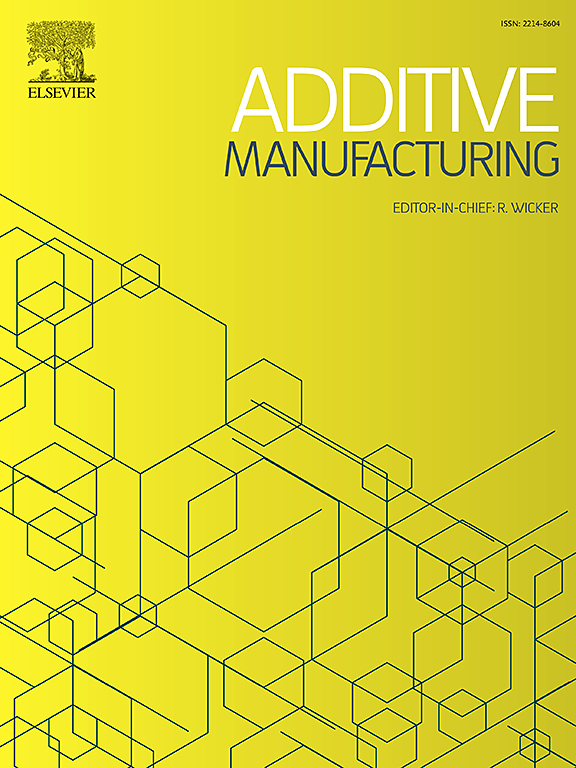基于光滑粒子流体力学的可控流形节点点阵结构几何建模
IF 10.3
1区 工程技术
Q1 ENGINEERING, MANUFACTURING
引用次数: 0
摘要
随着增材制造技术的发展,需要开发高性能的点阵结构几何建模方法。当前增材制造技术面临的一个关键挑战是有效控制晶格结构中节点的几何形状,以实现特定的功能增强,例如增强机械性能,从而减少应力集中问题。本文提出了一种新的几何建模方法,利用光滑粒子流体力学(SPH)平滑控制网格结构中节点的几何形状,适用于变半径、非均质构型。该方法被命名为基于sph的点阵几何建模(SLGM)。SLGM包括两个主要步骤:首先使用粒子集表示每个节点周围的几何形状,然后应用SPH粒子动力学模型(SPDM)并行控制每个节点的几何形状。将该方法应用于多个复杂的点阵结构设计,验证了其广泛的适用性。设计了两种优化后的格架梁,并进行了三点弯曲试验。结果表明,两种模型的结构承载能力均有显著提高,且提高程度不同,证明了所提出的几何建模方法的有效性。该建模算法具有较高的并行性,适合于大规模模型的生成。该方法为增材制造的结构优化和资源高效利用提供了有效的策略,具有推进增材制造技术在高性能领域应用的潜力。本文章由计算机程序翻译,如有差异,请以英文原文为准。

Smoothed Particle Hydrodynamics-based geometric modeling of lattice structures with controllable manifold nodes
The advancement of additive manufacturing has necessitated the development of high-performance geometric modeling methods for lattice structures. A critical challenge in current additive manufacturing technologies is effectively controlling the geometric shape of nodes within lattice structures to achieve specific functional enhancements, such as strengthening mechanical properties, thereby reducing stress concentration issues. This study presents a novel geometric modeling method employing Smoothed Particle Hydrodynamics (SPH) to smoothly control the geometric shape of nodes in lattice structures, suitable for variable-radius, heterogeneous configurations. This method is named SPH-based Lattice Geometric Modeling (SLGM). The SLGM comprises two primary steps: initially representing the geometric form around each node using a particle set, followed by the application of the SPH Particle Dynamics Model (SPDM) to control the geometric shape of each node in parallel. The method was applied to several intricate lattice structure designs, confirming its extensive broad applicability. Two optimized lattice-based beams were designed and subjected to three-point bending tests. The results showed a significant enhancement in structural load-bearing capacity for both models, with different levels of improvement, demonstrating the effectiveness of the proposed geometric modeling method. The modeling algorithm features high parallelism, making it suitable for generating large-scale models. This method provides effective strategies for structural optimization and efficient resource utilization in additive manufacturing, with the potential to advance the technology’s application in high-performance domains.
求助全文
通过发布文献求助,成功后即可免费获取论文全文。
去求助
来源期刊

Additive manufacturing
Materials Science-General Materials Science
CiteScore
19.80
自引率
12.70%
发文量
648
审稿时长
35 days
期刊介绍:
Additive Manufacturing stands as a peer-reviewed journal dedicated to delivering high-quality research papers and reviews in the field of additive manufacturing, serving both academia and industry leaders. The journal's objective is to recognize the innovative essence of additive manufacturing and its diverse applications, providing a comprehensive overview of current developments and future prospects.
The transformative potential of additive manufacturing technologies in product design and manufacturing is poised to disrupt traditional approaches. In response to this paradigm shift, a distinctive and comprehensive publication outlet was essential. Additive Manufacturing fulfills this need, offering a platform for engineers, materials scientists, and practitioners across academia and various industries to document and share innovations in these evolving technologies.
 求助内容:
求助内容: 应助结果提醒方式:
应助结果提醒方式:


